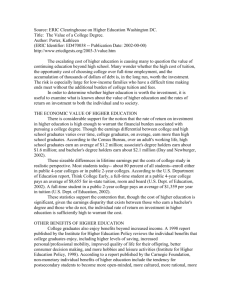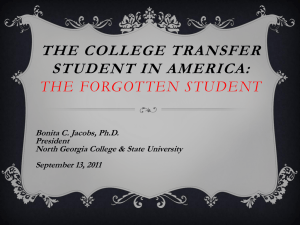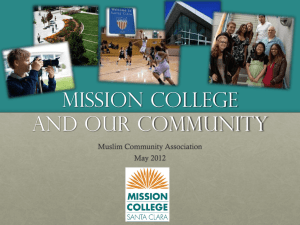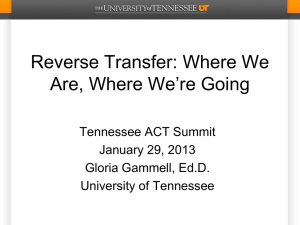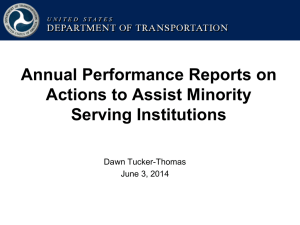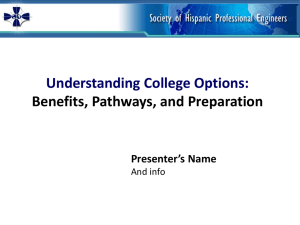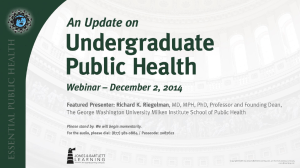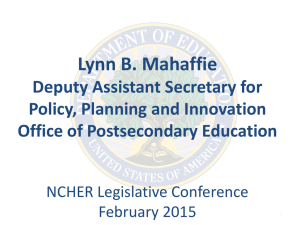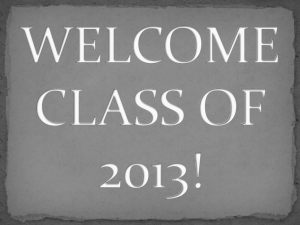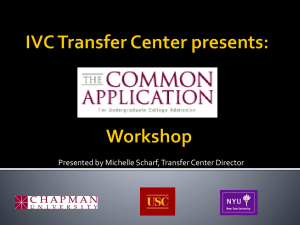GCC_Presentation_of_college
advertisement
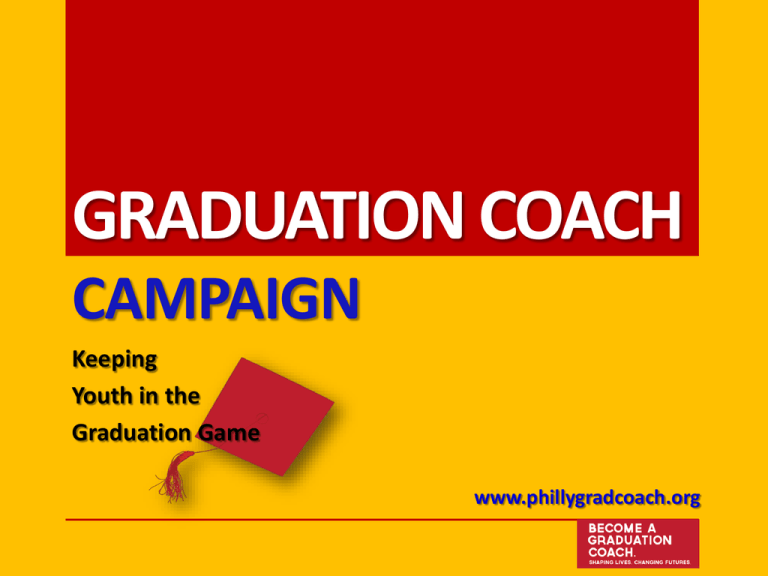
GRADUATION COACH CAMPAIGN Keeping Youth in the Graduation Game www.phillygradcoach.org THE WORLD HAS CHANGED! • Colleges once catered to wealthier, white students. Colleges today look for diversity and offer lots of help to lower-income families! • College costs have increased dramatically. More and more top students are turning to alternative options like community colleges. • The job market is changing every day! Things that were true twenty years ago are no longer accurate. That means that a lot of adults have misconceptions about college. How up-to-date are you? Jillian Kinzie, Megan Palmer, John Hayek, Don Hossler, Stacy A. Jacob and Heather Cummings. Volume 5 (3): September 2004. “Fifty Years of College Choice: Social, Political, and Institutional Influences on the Decision-Making Process.” Lumina Foundation for Education. http://www.luminafoundation.org/publications/Hossler.pdf Misconception #1 I’ve heard so much about college graduates who have student loans and can’t find a job. Maybe college isn’t a good idea! THE RELATIONSHIP BETWEEN EDUCATION AND EMPLOYMENT NATIONWIDE Source: Bureau of Labor Statistics. “Employment Projections.” Accessed Online 4 September 2013. http://www.bls.gov/emp/ep_chart_001.htm Misconception #2 When my student gets into college, my work is done! Percentage of Students who Graduate in Six Years PENNSYLVANIA COLLEGE COMPLETION RATES Graduation Rates, Pennsylvania 4-year public colleges 100 90 80 62.1 65.6 64.7 55.1 70 60 44.4 50 40 30 20 10 0 Ideal All students Asian White Hispanic Data from The Chronicle of Higher Education. http://collegecompletion.chronicle.com/state/#state=pa&sector=public_four Black Misconception #3 My student wants to apply to Ivy League schools, but they’re expensive! Alejandra Rincon , student at Princeton: “My parents always said that these schools were for the rich people that could afford it. And so I always thought that it would be very difficult for me to come.” “Opening the Door for Low-Income Students to Overcome 'Aristocracy' of Higher Ed.” PBS Newshour. 9 September 2013. http://www.pbs.org/newshour/bb/education/july-dec13/college_09-09.html LEARN TO LOOK PAST THE STICKER PRICE! Why are there so few low-income students in selective colleges? “The vast majority of low-income, high-achieving students in the U.S. do not even apply to any selective colleges, in spite of the fact that attending those institutions would cost less than the ones the students do attend thanks to generous financial aid packages.” Why should your student apply? “Don't let the big price tags nix an application to Harvard or Yale. The average student receiving financial aid on those campuses paid about a quarter of the public sticker price and most graduates leave their ivy-covered quads with smaller debts than peers who attended less prestigious schools.” Hoxby, Caroline M., and “Low-Income High-Achieving Students Miss Out on Attending Selective Colleges.” Brookings Papers on Economic Activity. Spring 2013. http://www.brookings.edu/about/projects/bpea/latest-conference/2013-spring-selective-colleges-income-diversity-hoxby Elliott, Phillip. “Ivy League College Students Avoid Student Debt Burden.” Huffington Post. September 10 2013. http://www.huffingtonpost.com/2013/09/10/ivy-league-student-debt_n_3897459.html TEST YOUR KNOWLEDGE! 1) Of every college in the United States, which do you think had the lowest average debt among its graduating students? 2) How much debt do you think graduates from this school had? What do you think is the average graduating debt in the United States? ANSWERS: 1) Princeton University 2) Average Princeton debt for 4-year students who borrowed: $5,096 (2013) Average U.S debt for 4-year students who borrowed: $26,600 (2011) THE BOTTOM LINE: You may end up paying much less than the school’s official tuition! Always give the financial aid office a call before assuming you can’t afford a school. Elliott, Phillip. “Ivy League College Students Avoid Student Debt Burden.” Huffington Post. September 10 2013. http://www.huffingtonpost.com/2013/09/10/ivy-league-student-debt_n_3897459.html Reed, Matthew, and Debbie Cochrane. “Student Debt and the Class of 2011.” The Project on Student Debt: Institute for College Access and Success. October 2012. http://projectonstudentdebt.org/files/pub/classof2011.pdf Misconception #4 My daughter is thinking about community college, but I’m concerned that she won’t be taken seriously if she doesn’t go to a 4-year college. “Opening the Door for Low-Income Students to Overcome 'Aristocracy' of Higher Ed.” PBS Newshour. 9 September 2013. http://www.pbs.org/newshour/bb/education/july-dec13/college_09-09.html MYTH #1: COMMUNITY COLLEGES AREN’T AS ACADEMICALLY STRONG AS 4-YEAR SCHOOLS THE REALITY: • Most students who attend community colleges do so for family or financial considerations, not because they weren’t competitive enough to get into 4-year colleges. • A lot of the faculty at community colleges simultaneously teach at 4-year schools. • When students who attend a community college transfer to a 4-year school like Temple, their diploma will be the same as though they had attended that school for all four years. FAMOUS GRADUATES OF COMMUNITY COLLEGES: • Nolan D. Archibald is the CEO of the Black & Decker Corporation and was the youngest CEO of a Fortune 500 Company when he was appointed at the age of 42. • Eileen Marie Collins is a NASA astronaut and first woman Space Shuttle Commander. • Daniel Hayes is an American transplant surgeon in Charlotte, North Carolina. • John Walsh attended Cayuga Community College before becoming the leading advocate for child safety and legislation reform. • Benjamin Cayetano was the Governor of Hawaii from 1994 to 2002. Giang, Vivian. “The Most Famous Community College Students of All Time.” 3 August 2011. http://www.businessinsider.com/the-most-famous-people-who-went-to-community-college-2011-7# MYTH #2: IT IS DIFFICULT TO TRANSFER FROM A COMMUNITY COLLEGE TO A 4-YEAR SCHOOL THE REALITY: Community colleges offer significant support to their students who are transferring. Most importantly, many have dual enrollment agreements with 4-year schools. This means that: • Credits often transfer easily between the 2-year institution and the 4-year college • Students who maintain a minimum GPA are usually guaranteed admission to the partner 4-year school • Students may be eligible for reduced tuition at the 4year school Misconception #5 The average SAT scores of incoming students is much higher at this college than the state school. It must be a better school! Why might this be backward thinking? “Opening the Door for Low-Income Students to Overcome 'Aristocracy' of Higher Ed.” PBS Newshour. 9 September 2013. http://www.pbs.org/newshour/bb/education/july-dec13/college_09-09.html You are trying to decide which fridge to buy, and you need to decide which company is better. Would you prefer the company that brings the most expensive materials into their factory, or the that one actually puts better fridges on the shelves? This may seem silly, but people do this all the time when comparing colleges! What goes in is much less important than what comes out! Great colleges aren’t necessarily those that pull in the “best” students at the beginning, but rather the ones that transform students to make them great. “Trash Art” Parents and students often compare the average GPA’s and SAT scores of incoming students to decide which schools are “better.” Instead, they should focus on: 1) How much do students actually learn when they are there? 2) How well prepared are they for work or graduate school when they graduate? Statistics that REALLY matter: • Acceptance rates into medical/law/graduate school • Employment statistics after graduation. These can be hard to find online, so contact the school’s Office of Career Services Taking a Breather! Here’s a fun activity. In preparation for the next section, take a guess at which of these college majors best prepare students for medical school or law school! MCAT: A six-hour test students must take to get into medical school. Which of these majors get the highest scores? What about the lowest? LSAT: A challenging test students must take to get into law school. Which majors get the highest scores? What about the lowest? • • • • • • • Philosophy • Prelaw • Criminal Justice • Physics • Economics • English Physics Biology English Economics Premed Engineering ANSWERS: 1. Engineering 2. Physics 3. Economics 4. English 5. Biology 6. Premed ANSWERS: 1. Physics 2. Philosophy 3. Economics 4. English 5. Prelaw 6. Criminal Justice “Average LSAT Scores for 29 Majors w/ over 400 Students Taking the Exam.” Department of Philosophy, University of Florida. Accessed 28 August 2013. http://www.phil.ufl.edu/ugrad/whatis/LSATtable.html “MCAT, LSAT, and Physics Bachelors.” American Institute of Physics. February 2010. http://www.aip.org/statistics/trends/reports/mcat2009.pdf Misconception #6 My son wants to study art/philosophy/English, but I think he should study engineering. Otherwise he’ll never get a job! “Does the College Major Matter? Not Really” (title of a New York Times article from April 2013) • Only 27% of college graduates have a job related to their major • Employers care most about skills that have little to do with a specific major. Teamwork and interpersonal, problem solving, critical thinking, and written and oral communication skills are developed in nearly all majors • It is more important that students major in subjects that interest them! David Muir is an anchor and correspondent for ABC World News. He works with plenty of people who do not have journalism degrees. The commonality among them, he says, is that “we all majored in what we were interested in. The curiosity and the willingness to adapt are more important than what the degree is in.” Plumer, Brad. “Only 27% of college grads have a job related to their major.” The Washington Post. 20 May 2013. http://www.washingtonpost.com/blogs/wonkblog/wp/2013/05/20/only-27-percent-of-college-grads-have-a-job-related-to-their-major/ Selingo, Jeffrey J. “Does the College Major Matter? Not Really.” The New York Times. 29 April 2013. http://thechoice.blogs.nytimes.com/2013/04/29/does-thecollege-major-matter-not-really/ PRACTICING KEY CONVERSATIONS TASK: We will now break up into small groups. Each group will choose at least one scenario from the “Practicing Key Conversations” Handout. As a group, address the situation by discussing these questions: 1) What are some possible solutions to this situation? 2) How would you carry out a Key Conversation about this situation? What reactions or resistance might you expect from your student? 3) What additional resources would you need to support your young person through this process? “Step Up to College” Guide • pp. 2-5, “Why Go to College” • pp. 6-10, “Preparing Yourself for College” • pp. 11-15, “Finding the Right College for You” • pp. 16-22, “Applying to College” • pp. 23-31, “Paying for College” • pp. 32-34, “The Transition to College”
